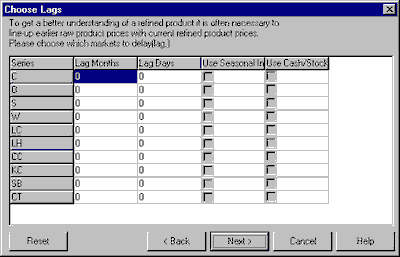
For beginning users, these options are rarely used, but here is how they work:
Lagging one or more series is sometimes necessary. The Hog and Corn markets are highly related, but much more so if you account for production time as well as production costs. Farmers would rather have some return on investment than none. So even if the price of corn goes up, hog farmers will typically continue raising their current hogs. But if the corn prices go high enough, hog farmers might slaughter more hogs than intended, pushing the hog prices down. It is only in the new crop of hogs that the old crop corn prices are directly felt. Thus in studying hog and corn prices, a lag to the corn prices might be used to understand or explain the hog prices.
A series may be replaced or supplemented with its seasonal index. The seasonal index employed is a 32-bit port of the one available under Unfair Advantage as written by Bob Pelletier. When using a seasonal index on daily data, a lag of, say, 240 trading days would be equivalent to a 10-trading-day forward forecast of expected seasonal influence or "pull" in the market because the final year of a seasonal index is a copy of the developed cumulative index over time.
If you included an index market to get the index, a check box is provided so that you can include the cash price series instead of or in addition to the Back Adjusted or Perpetual Contract series previously chosen. A word of warning, however, the date range presented and validated is based on the futures data. The cash data may have a different range. If the cash series is not present through out the date range, the gap is treated as a series of holidays and is filled in with the last price.
Once you have set the options in this screen, press the "Next" button to continue. Setup is complete at this point; Multi-Market Analyzer will now do a correlation and factor analysis, which may take some time before getting to the next screen, "Factor Analysis". For more information on time series analysis and forecasting, see [Chatfield 1989] and [Abraham Ledolter 1983].